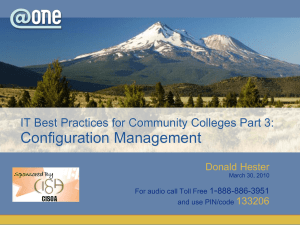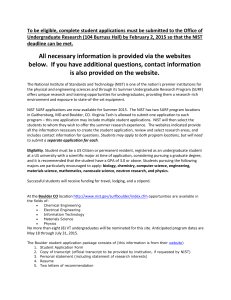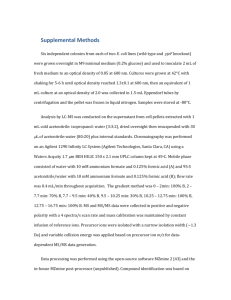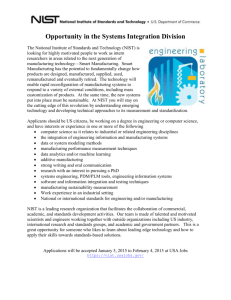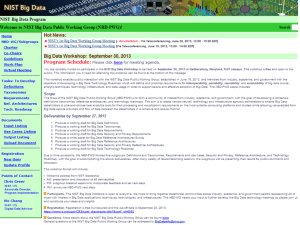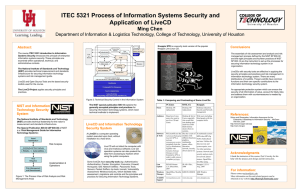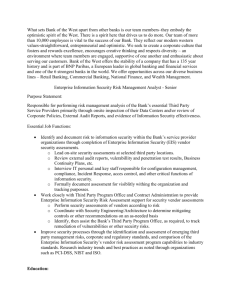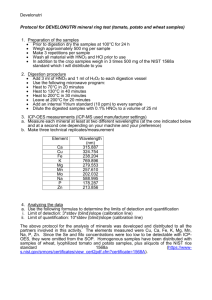Cell and Tissue Mechanics Contact: Timothy
advertisement
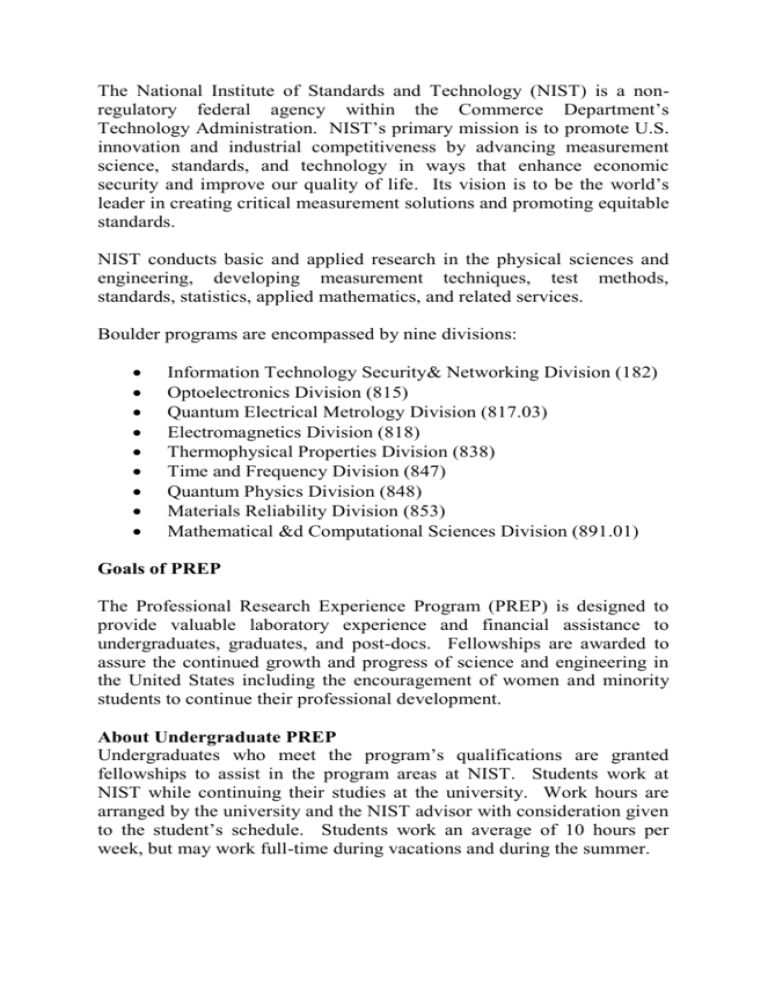
The National Institute of Standards and Technology (NIST) is a nonregulatory federal agency within the Commerce Department’s Technology Administration. NIST’s primary mission is to promote U.S. innovation and industrial competitiveness by advancing measurement science, standards, and technology in ways that enhance economic security and improve our quality of life. Its vision is to be the world’s leader in creating critical measurement solutions and promoting equitable standards. NIST conducts basic and applied research in the physical sciences and engineering, developing measurement techniques, test methods, standards, statistics, applied mathematics, and related services. Boulder programs are encompassed by nine divisions: Information Technology Security& Networking Division (182) Optoelectronics Division (815) Quantum Electrical Metrology Division (817.03) Electromagnetics Division (818) Thermophysical Properties Division (838) Time and Frequency Division (847) Quantum Physics Division (848) Materials Reliability Division (853) Mathematical &d Computational Sciences Division (891.01) Goals of PREP The Professional Research Experience Program (PREP) is designed to provide valuable laboratory experience and financial assistance to undergraduates, graduates, and post-docs. Fellowships are awarded to assure the continued growth and progress of science and engineering in the United States including the encouragement of women and minority students to continue their professional development. About Undergraduate PREP Undergraduates who meet the program’s qualifications are granted fellowships to assist in the program areas at NIST. Students work at NIST while continuing their studies at the university. Work hours are arranged by the university and the NIST advisor with consideration given to the student’s schedule. Students work an average of 10 hours per week, but may work full-time during vacations and during the summer. Fellowships for undergraduates are awarded each semester and include tuition assistance plus an hourly salary. Freshmen receive $8 an hour, Sophomores $9 an hour, Juniors $10 an hour, and Seniors $11 an hour. About Graduate PREP Graduate PREP fellowships are granted to students in master’s and doctoral degree programs whose thesis work closely matches research performed at NIST. Graduate fellowships are awarded to sponsor the student through graduation, but may not exceed six years. Each graduate fellowship will be reviewed annually to confirm that the student is making progress toward a degree and that the research being performed under this fellowship is supportive of the student’s thesis. The underlying assumptions of the graduate program are that: (1) the students would be strong candidates for permanent research positions with NIST, and (2) the students’ thesis would be compatible with NIST research programs. Graduate fellowships are awarded for a period of one year, and can be renewed annually up to a total of six years. Graduate fellowships include yearly tuition assistance, fees, and insurance, plus a predetermined salary comparable to that of a Research Assistant position in the student’s department at the university. The number of hours a student spends in the laboratory will be determined by mutual agreement among the university, the NIST advisor, and the student. In most cases, students will be expected to work full time in the laboratory when they are not attending classes. About Post-Doctoral PREP Postgraduate PREP fellowships are granted to those who have completed doctoral programs. Post-doctoral PREP fellowships are negotiated between the university and NIST and may consist of a salary, benefits, travel, moving, and other miscellaneous expenses. Qualification Requirements – All Levels Undergraduates must be full-time students at the university and must provide a current grade transcript showing a minimum 3.0 GPA. Graduates must be full-time students (based on the graduate school’s definition of a full-time student) at the university and must provide a current official grade transcript showing a minimum 3.0 GPA and two confidential letters of recommendation. Post-Docs must be affiliated with the university during the term of the fellowship, provide an official grade transcript showing their Ph.D. conferred with a minimum 3.0 GPA, and one confidential letters of recommendation. Fellowship awards are dependent upon the needs of NIST and the availability of funding. Application for PREP Universities must qualify to participate in PREP through application to a Federal Register Announcement. Institutions currently participating are the University of Colorado at Boulder, Colorado School of Mines, Colorado State University, and the University of Denver. Students of these institutions may obtain application forms from their university. Participation is limited to these schools until the next application Announcement is published in the Federal Register in the Spring of 2009 for new awards taking effect on August 1, 2009. CU undergraduate and graduate students must complete an application available through the CU Career Services website: http://careerservices.colorado.edu/public.cs?studentNIST or http://careerservices.colorado.edu/ -- click on “CU & NIST PREP”. Post-docs wishing to apply for a PREP fellowship need not have received their Ph.D. from CU, but must complete a brief CU employment application available on-line at CU’s Human Resources web site. Before completing the application, obtain the posting number from Tiffany Mason in the Career Services Office at tiffany.mason@colorado.edu or 303-492-4412. The offer and acceptance of any fellowship under PREP does not obligate the Fellow, the University, NIST, or the United States Government in any way with regard to future employment or service of any kind. ************************** INFORMATION TECHNOLOGY SECURITY & NETWORKING DIVISION -- Customer Access and Support Division - 182 Contact: Lisa Eldrige 303-497-5375 itac@boulder.nist.gov The Boulder Customer Access and Support Division supports personal computers for all of NIST Boulder. The group members provide help desk (iTAC) support, managed desktop support via LANDesk and Symantec and maintenance services for both hardware and software. The group is also a focal point for collecting, reviewing, evaluating, and disseminating information about personal computer hardware, software, and applications throughout NIST. OPTOELECTRONICS DIVISION – 815 Optoelectronic devices produce, transmit, manipulate, or detect optical radiation. The Optoelectronics Division at NIST provides measurement technology, standards, and traceability to support the U.S. optoelectronics industry. Much of our work focuses on optoelectronics used in fiber optic communications, and includes measurement research in optical components, optical fiber, optical detectors and sources, and wavelength standards. We also support industrial and medical applications of lasers and detectors. And we support the manufacture of semiconductor optoelectronic devices by providing optical materials metrology and epitaxial growth standards, and performing research toward nanofabrication and metrology of novel devices. Sources and Detectors Group 815.01 Contact: Marla Dowell 303-497-7455 mdowell@boulder.nist.gov Lasers and associated detectors of various types are used extensively in industrial facilities, telecommunication fields, research laboratories, military systems, and medical institutions. This group is responsible for developing the national-level metrology to support the sources and detectors used in these applications. The Laser Radiometry Project develops measurement methods and standards for characterizing laser sources and detectors. They develop and maintain measurement services for laser power and energy, optical fiber power, and related parameters such as spatial uniformity, spectral responsivity, and linearity. The present tasks for the Laser Radiometry Project include developing measurement methods using tunable laser sources and designing new types of detectors as well as developing measurement methods and standards for use with 157 nm excimer lasers and extending NIST’s pulsed-laser metrology efforts to include new laser wavelengths. The High-Speed Measurements Project provides metrology, standards, and measurement services relating to temporal properties of optical sources and detectors used in association with optoelectronic systems. Its tasks include developing methods to accurately characterize the impulse and frequency responses of high speed detectors. Pulse laser measurements are also being developed to support, for example, excimer laser users and manufacturers. The Display Metrology Project develops measurement methods and devices to characterize displays. Optical Fiber and Components Group Contact: Kent Rochford 815.03 303-497-5285 rochford@boulder.nist.gov The optical fiber communications industry is moving to higher bandwidth systems by increasing the bit rate and incorporating multiple wavelength channels. High-bandwidth systems require accurate measurement of spectral, polarization, dispersion, and nonlinear properties of optical fiber and components. The Interferometry and Polarimetry Project concentrates on polarization and dispersion properties. Increasing the overall data rate in communication systems tends to reduce a system’s tolerance to such parameters as chromatic dispersion, relative group delay, polarization-mode dispersion, polarization-dependent loss, and polarization-dependent spectral transmission. We are developing new measurement techniques for these parameters and are working to increase the spectral and temporal resolution of existing methods. The Spectral and Nonlinear Properties Project concentrates on the spectral and nonlinear properties of optical fiber and components. We are developing spectral characterization techniques and wavelength calibration transfer standards to help industry evaluate optical components and calibrate wavelength-measuring instruments. Because of the increasing importance of nonlinear effects, we are developing measurement techniques to characterize Raman gain and supercontinuum generation in optical fiber. Although the Group’s current program is primarily focused on the optical fiber communications industry, it also has applications to optical fiber sensors, particularly fiber Bragg grating strain sensors. Optoelectronic Manufacturing Group 815.04 Contact: Robert Hickernell 303-497-3455 bobhick@boulder.nist.gov Many of the challenges of the optoelectronics industry lie in removing barriers to cost-effective manufacturing. This group grows compound semiconductor and superconductor structures (including nanostructures), fabricates advanced prototype photonic devices, and characterizes them in several ways to support their applications in optical communication, displays and lighting, signal processing, homeland security, quantum cryptography, quantum optics, metrology, and others. The Semiconductor Growth and Devices Project develops semiconductor composition standards, improves the accuracy of in situ measurements during epitaxial growth, and develops highly sensitive measurements of impurity concentrations in semiconductor source materials. It also develops semiconductor nanowire and nanowire devices, and ordered quantum dot arrays. The Optical Materials Metrology Project develops methods of cw and time-resolved photoluminescence and near-field optical spectroscopy and correlates them with complementary methods such as high-resolution x-ray and specral photoconductivity to determine the optical, electronic, and structural properties of group III-nitride films and nanowires. It also develops prototype nanowire devices and test structures including lasers, LEDs, and FETs. The Nanostructure Fabrication and Metrology Project develops modeling, fabrication, and measurement methods for semiconductor nanostructures, including quantum dots and photonic crystals. It develops new devices for singlephoton and entangled-photon emission and detection for application to quantum-based radiometry, quantum communication and computation, and fundamental tests of quantum mechanics. The Quantum Information and Terahertz Technology Project develops and applies single photon detectors based on superconducting technology in the optical and infrared spectral regions to metrology, science and new quantum-based communication systems. It also develops and evaluates metrological methods, components, and technology for imaging and spectroscopy from ~100 GHz to several THz in frequency. Applications include remote detection of contraband, industrial processing, and remote identification of chemicals. QUANTUM ELECTRICAL METROLOGY DIVISION – 817 QUANTUM DEVICES GROUP – 817.03 The Quantum Devices Group uses quantum effects (especially superconductivity), low temperatures (to reduce thermal noise), and state-of-the-art micro- and nanofabrication (to achieve small sizes) to create unique-in-the-world measurement systems and techniques. Major activities of the Group include: Josephson junction array voltage standards, the largest superconducting integrated circuits in actual use. These quantumbased standards for revolutionized how voltage is measured. Quantum sensors that combine superconducting sensors with superconducting quantum interference device (SQUID) readouts to create the world's most sensitive energy detectors for photons (from microwaves through gamma rays) and particles (including alpha particles and macromolecules). Systems already in use include x-ray spectrometers for materials analysis, sub-mm cameras for astronomy, and gamma and alpha spectrometers for nuclear forensics. Quantum computing devices based on superconducting circuits that create artificial "atoms" which manipulate, transfer and measure quantum states. Quantum limited microwave amplifiers that have to potential to perform microwave "quantum optics" on-chip. Quantum magnetic sensors which extend the sensitivity for detecting magnetic fields for applications including magnetic tape forensics, geomagnetism, and biomagnetism. Quantum Voltage Contact: Sam Benz 303-497-5258 benz@boulder.nist.gov We are looking for researchers who are interested applying their solid state physics or electrical/microwave engineering expertise to develop practical and useful superconducting circuits, devices, and systems. Currently, we have active research areas in the following: high-speed Josephson junctions with barriers near the metal-insulator transition for digital superconducting integrated circuits, low-loss microwave circuit with lumped superconducting passive components, tunable phase-locked oscillators, and extending precision quantum-based waveform synthesis from audio frequencis to rf and microwaves. We are also developing the measurement techniques for ac and dc voltage metrology, rf and microwave communication, high-speed digital computation, and precision electronic thermometry. Web page: http://qdev.boulder.nist.gov/ under Quantum Voltage and JNT. The Quantum Devices Group’s other programs cover the following technical areas: Nanoscale Cryoelectronics and Emerging Electronic Materials Contact: David Rudman 303-497-5081 rudman@boulder.nist.gov Cryogenic Sensors Magnetic Recording Measurements Contact: Kent Irwin 303-497-5911 irwin@boulder.nist.gov Contact: David P. Pappas 303-497-3374 pappas@boulder.nist.gov ELECTROMAGNETICS DIVISION -- 818 This division carries out a broad range of technical programs focused on the precise realization and measurement of physical quantities throughout the radio spectrum. Key directions include: (a) the development of reference standard artifacts, services and processes with which industry can maintain internationally recognized measurement traceability; (b) the advancement of technology through the development of new measurement techniques that are theoretically and experimentally sound as well as relevant and practical; (c) the assessment of total measurement uncertainties; and (d) the provision of expert technical support for national and international standards activities. We strive to perform leading-edge, high-quality research in metrology that is responsive to national needs. Division programs cover the following technical areas: Radio Frequency Electronics Group 818.01 Contact: Ron Ginley 303-497-3634 ronald.ginley@nist.gov The Radio-Frequency Electronics Group conducts theoretical and experimental research to develop basic metrology, special measurement techniques, and measurement standards necessary for advancing both conventional and microcircuit guided-wave technologies; for characterizing active and passive devices and networks; and for providing measurement services for scattering parameters, power, waveform, noise, material properties, and other basic quantities. Projects in this group include: Microwave Measurement Services Through the microwave measurement services, we establish, maintain, and disseminate the national standards for RF and microwave quantities. This provides the U.S scientific and industrial base with access to a measurement system that is readily available, reliable, accurate, reproducible, and internationally consistent. We provide a broad range of state-of-the-art RF and microwave calibration services, which include scattering parameters, attenuation, power, thermal noise, and waveform. Contacts: Ron Ginley Tom Crowley 303-497-3634 303-497-4133 ronald.ginley@nist.gov Thomas.Crowley@nist.gov Dave Walker 303-497-5490 david.walker@boulder.nist.gov Jim Randa 303-497-3150 James.Randa@nist.gov Micro/Nano Electronics This program seeks to develop new metrology tools for next-generation electromagnetic applications in high-speed telecommunications, microelectronics, magnetic data storage, computing, and biomedical systems. These new tools are focused on higher operating frequencies, wider bandwidths, increased dynamic range, smaller length scale, and more complex materials, devices, and systems. Contacts: Mike Janezic Jim Booth 303-497-3656 303-497-7900 Michael.Janezic@nist.gov James.Booth@nist.gov Pavel Kabos 303-497-3997 Pavel.Kabos@nist.gov Dylan Williams 303-497-3138 Dylan.Williams@nist.gov Electromagnetic Properties of Materials The electromagnetic properties of materials program develops theory and methods for measuring the complex permittivities and permeabilities of materials at frequencies from RF through terahertz. Materials of interest include electronic substrates, thin films, liquids, biological specimens, and engineered materials. Characterization is performed of both bulk and micro and nanoscale properties. Contacts: Jim Baker-Jarvis Mike Janezic 303-497-5621 303-497-3656 James.Baker-Jarvis@nist.gov Michael.Janezic@nist.gov Bill Riddle 303-497-5752 Bill.Riddle@nist.gov Radio-Frequency Fields Group 818.02 Contact: Perry Wilson 303-497-3406 perry.wilson@nist.gov The Radio-Frequency Fields Group conducts theoretical and experimental research necessary for the accurate measurement of freespace electromagnetic field quantities; for the characterization of antennas, probes and antenna systems; for the development of effective methods for electromagnetic compatibility assessment; for the measurement of radar cross section and radiated noise; and for providing measurement services for essential parameters. Projects in this group include: Antennas and Antenna Systems The antennas and antenna systems program develops theory and techniques for measuring the gain, pattern, and polarization of advanced antennas; for measuring the gain and noise of large antenna systems; and for analyzing radar cross-section measurement systems. Contacts: Mike Francis Ron Wittmann 303-497-5873 303-497-3326 Michael.Francis@nist.gov Ronald.Wittmann@nist.gov Katie MacReynolds 303-497-3471 Katherine.MacReynolds@nist.gov Electromagnetic Compatibility The electromagnetic compatibility program develops theory and methods for measuring electromagnetic field quantities and for characterizing the emissions and susceptibilities of electronic devices and systems, in both the frequency and time domains. Contacts: Perry Wilson David Novotny 303-497-3406 303-497-3168 Perry.Wilson@nist.gov David.Novotny@nist.gov Galen Koepke 303-497-5766 Galen.Koepke@nist.gov Chris Holloway 303-497-6184 Christopher.Holloway@nist.gov Bob Johnk 303-497-3737 Robert.Johnk@nist.gov Kate Remley 303-497-3652 Kate.Remley@nist.gov Magnetics Group 818.03 Contact: Ron Goldfarb 303-497-3650 ron.goldfarb@nist.gov The Magnetics Group develops measurement technology for industries broadly concerned with magnetic information storage, biomagnetic imaging, and superconductor power, spanning the range from practical engineering to theoretical modeling. The group disseminates the results of its research through publications in refereed journals, presentations at conferences and workshops, and participation in standards organizations. Projects in this group include: Nanomagnetics The program in nanomagnetics undertakes experimental research on fundamental aspects of magnetization switching, precession, and damping at the nanoscale for applications in magnetic information storage (such as magnetoresistive read heads, recording media, and magnetic random-access memory) and magnetic devices (such as oscillators driven by the transfer of quantum-mechanical electron spin angular momentum to magnetic films). Contacts: Tom Silva Steve Russek 303-497-7826 Thomas.Silva@nist.gov 303-497-5097 Stephen.Russek@nist.gov Bill Rippard 303-497-3882 William.Rippard@nist.gov Biomagnetics This program is developing new metrology and standards for biomedical imaging based on magnetic resonance, magnetic nanoparticles, and low field sensing of biomagnetic fields. Micromechanical and magnetic resonance systems are being developed to characterize nanomagnetic systems and their use for measuring, detecting, and manipulating biomolecules for health and national security applications. Contacts: John Moreland Steve Russek 303-497-3641 303-497-5097 John.Moreland@nist.gov Stephen.Russek@nist.gov Superconductivity The program in superconductivity develops measurement methods for the electric, magnetic, and mechanical properties of high-temperature and low-temperature superconductor wires and tapes for electric power and medical applications. Contacts: Loren Goodrich 303-497-3143 Loren.Goodrich@nist.gov THERMOPHYSICAL PROPERTIES DIVISION – 838 This division conducts basic and applied research on the thermophysical properties of fluids, on separation processes and technologies, and on advanced cryogenic processes and systems. The fluid properties research focuses on an integrated program of measurement techniques and experimental data, critical evaluation and correlation of data, and theoretical models to provide standard-reference-quality information on the thermophysical properties of industrially important fluids and fluid mixtures. This information (data, models, computer packages) is needed for custody transfer applications and for efficient design and operation of processes in the aerospace, chemical, energy, environmental, natural gas, and petroleum industries. Alternative energy sources, including biofuels, are areas of emphasis. The process separations research involves fundamental and applied studies needed to provide the chemical process industry with efficient and globally competitive chemical separations. The focus is mainly on relatively large-scale operations of the type used in chemical plants, but also includes smaller scale problems involving trace contaminants and the application of chemical analysis to process control. The cryogenic research involves fundamental studies of advanced refrigeration systems, cryogenic fluid flow, and heat transfer. A major focus is on the development of cryocooler and heat exchanger technology critical to a wide range of military, commercial, and industrial applications involved in the cryoelectronic, semiconductor, energy, environmental, space, medical, and related industries. Thermodynamics Research Center 838.01 Contact: Michael Frenkel 303-497-3952 frenkel@boulder.nist.gov TRC is one of the oldest and most authoritative Data Centers in the world. TRC specializes in the collection, evaluation, and correlation of thermophysical, thermochemical, and transport property data for organic compounds. Major data products include the TRC Thermodynamic Tables for Hydrocarbons and Non-Hydrocarbons; the International Data Series for selected mixtures; data books providing critically evaluated data for key properties; and a variety of electronic databases containing critically assessed data. The unprecedented growth of thermophysical property data (almost doubling every 10 years) makes it practically impossible to employ traditional (static) methods of data evaluation. The new concept of dynamic data evaluation has been developed at TRC. This concept requires the development of large electronic databases capable of storing essentially all ‘raw’ experimental data with detailed descriptions of relevant metadata and uncertainties. The combination of such databases with artificial intelligence software leads to the possibility of producing critically evaluated data reports automatically “to-order.” Properties for Process Separations Project 838.07 Contact: Tom Bruno 303-497-5158 bruno@boulder.nist.gov This project performs basic and applied research on separations on the analytical and process scales. Our current focus in on real fuels, including fuels for rocket motors, gas turbine aviation engines, as well as motor fuels. Our motor fuel work encompasses not only classical petroleum and coal derived fuels but also novel fuels such as biofuels for both spark and compression ignition engines. In addition to the work on liquid fuels, we also have active programs on gaseous fuels such as natural gas and LPG. We develop state-of-the-art measurement techniques and models to characterize fluid properties and separation processes and also other related processes central to the separation unit operation. Our novel metrologies are geared toward highly complex fluids with many components. The project also provides critically evaluated physicochemical data and models that are needed to develop more robust and species specific separation processes on scales that range from large commercial outputs on the plant floor to analytical procedures in the laboratory. Experimental Properties of Fluids Group Contact: Mark McLinden 838.07 303-497-3580 markm@boulder.nist.gov Our group has extensive capabilities for wide-ranging, high-accuracy fluid thermophysical properties measurements. We perform experimental research on the thermodynamic and transport properties of industrially important fluids and fluid mixtures covering temperatures from 30 K to 700 K at pressures up to 70 MPa; the full composition range is covered for mixtures. We use state-of-the-art apparatus to measure properties such as pressure-volume-temperature (PVT) behavior, vapor pressure, heat capacity, speed of sound, phase equilibrium (VLE) behavior, viscosity, and thermal conductivity. The group's current efforts are focused on conventional and alternative fuels (especially biofuels) and reference fluids for density and viscosity. The group has a long history of research in fluid properties, and over the past 40 years it has provided comprehensive measurements on a wide variety of fluid systems including common inorganics, cryogens, hydrocarbons, supercritical fluids, aqueous systems, alternatives to the CFC refrigerants, ionic liquids, and fuels. It works closely with the Theory and Modeling of Fluids Group and others to provide the data needed to develop comprehensive formulations of the properties of these fluids. Theory and Modeling of Fluids Group 838.08 Contact: Marcia Huber 303-497-5252 huber@boulder.nist.gov This group performs theoretical research, modeling activities, and computer tasks related to the determination and application of thermodynamic and transport properties of fluids over wide ranges of temperature, pressure, and composition. The fluids of interest include pure or mixed common inorganic and industrial chemicals, natural gas and petroleum fluids, cryogens, biofuels, refrigerants, aqueous systems, complex systems, and model systems. The group develops computer programs to calculate or predict fluid properties with uncertainties commensurate with the available experimental data and the complexity of the system. The studies include research into properties near phase transitions, including solid-fluid boundaries, critical points, properties of dilute systems, the relationship between structure and macroscopic properties, and computer simulation studies. Cryogenic Technologies Project 838.00 Contact: Ray Radebaugh 303-497-3710 radebaugh@boulder.nist.gov This project performs research on cryogenic processes with emphasis on new refrigeration methods for producing cryogenic temperatures. Studies of pulse tube refrigerators, regenerative and recuperative heat exchangers, compressors, mixed refrigerant processes, and various other cryocooler systems and components are a part of this research. Other research areas include measurement techniques for cryogenic fluid flow and heat transfer. The project develops advanced measurement techniques, standard measurement practices, and mathematical models for cryogenic processes and designs and tests prototype systems and compares their performance with models in order to improve modeling and design techniques. The improved processes and design techniques assist U.S. industry in the development of new and/or improved products utilizing cryogenic processes in a wide range of applications, including commercial, military, space, medical, environmental, transportation, and energy. TIME AND FREQUENCY DIVISION – 847 The NIST Time and Frequency Division is responsible for the development and operation of standards of time and frequency and coordination with other world standards, provision of time and frequency services to the United States, and basic and applied research in support of future standards, dissemination services, and measurement methods. A new frequency standard which uses cooled atoms in a fountain geometry has been developed, and yet more advanced concepts for new standards are being studied. NIST has also initiated a program to develop methods for measuring phase noise in high-quality phase noise characterization amplifiers, frequency multipliers, oscillators, and other electronic components over a broad frequency range. Ion Storage Group 847.10 Contact: David Wineland 303-497-5286 wineland@boulder.nist.gov The Ion Storage Group studies laser-cooled atomic ions confined in electromagnetic traps. The dynamics of motion and internal states of individual ions and larger collections (non-neutral plasmas) of ions are explored using laser beam manipulation and detection. Emphasis is placed on high-resolution spectroscopy, since this has direct application to atomic-ion frequency standards. The group has a long history in this field including the first demonstration of laser cooling of atoms to cryogenic temperatures and optical clocks based on Hg+ and Al+, which have the smallest reported uncertainties. These techniques are applied to additional topics including quantum information processing, quantumlimited metrology, and tests of fundamental physics (e.g. searches for time variation of the fundamental constants). Positions are available for graduate or postgraduate research. Atomic Frequency Standards Group Contact: Tom Parker 303-497-7881 tparker@boulder.nist.gov This group has completed a new atomic standard based on the fountain concept. The evaluation of systematic uncertainties in this standard involves research into a variety of effects including the collision-shift effect, line-pulling effects, second-order Zeeman splitting, and the second-order Doppler shift. The electronic systems for control of such atomic clocks present a number of particularly challenging and unique design opportunities in digital servosystems and automation. The NIST Time Scale is composed of an ensemble of atomic clocks, the outputs of which are combined in an optimal sense to produce a single output that is relatively insensitive to problems arising in individual clocks. This is accomplished using algorithms and atomic-clock modeling. Staff in the group have led the development of the statistical measures used in this field (e.g., the Allan variance). Accurate time transfer at the one nanosecond (or better) level using satellites is also of substantial interest since the group is responsible for international time coordination. Time and Frequency Metrology Contact: Dave Howe 303-497-3277 dhowe@boulder.nist.gov The accurate measurement of phase and amplitude noise in electronic systems is important in a variety of fields including accurate synchronization, surveillance, earth and space-based geolocation and data telecommunications and radar. This NIST group is a world leader in development of methods for characterization and control of phase noise. These methods are being applied to the development of improved amplifiers, oscillators, and other electronic components. This group provides noise-measurement calibration services up to 100 GHz, on-site certification and measurement assurance to other metrology laboratories, and vibration-induced noise measurements. Time and Frequency Services Group Contact: John Lowe 303-497-5453 lowe@boulder.nist.gov This group is developing new and improved methods for accurate distribution of time and frequency signals. These include a major advance in power output for LF station WWVB and studies of timing distribution through telecommunications satellites. A number of subjects within this group represent engineering advances appropriate for graduate or postgraduate research. Network Synchronization Contact: Judah Levine 303-497-3903 jlevine@boulder.nist.gov Part of the work in this area focuses on the development of new methods for distributing time and frequency information in a digital format. Examples of projects include more efficient utilization of the NIST Automated Computer Time Service and methods for synchronizing the clocks of computers connected to both local and wide-area networks where the uncertain network delays complicate the accurate transfer of time. These problems involve programming, statistical analysis, and possibly some design and construction of digital circuits. Optical Frequency Measurements Group Contact: Leo Hollberg 303-497-5770 hollberg@boulder.nist.gov This group develops methods for accurate measurement of optical frequencies and the development of stable and tunable optical sources, in support of advanced atomic frequency standards and optical frequency measurements for emerging optical communication systems. The work often involves the development of line-narrowed and stabilized lasers based on diode lasers. The group is also applying femtosecond lasers to the synthesis and measurement of optical frequency and has embarked on a project aimed at developing a chip-scale atomic clock. QUANTUM PHYSICS DIVISION – 848 Quantum Physics is the division through with NIST participates in JILA, a cooperative institute between NIST and the University of Colorado, located on the CU campus. The interdisciplinary nature of the division reflected by the several areas in which any or all of the members participate: Fundamental and precision measurement, atomic and molecular physics, optical physics, bioscience and nanoscience. NIST scientists, University faculty, and visiting scientists work together to produce some of the most exciting results in modern research in physics and chemistry. Contact: Steve Cundiff 303-492-7858 Steven.cundiff@colorado.edu Ultrafast lasers, generating pulses down to 10 femtoseconds in duration, are used in a number of research areas. Their access to short time scales is used to study the influence of many-body phenomena in semiconductors and in dense atomic vapors. The large peak powers are utilized in second harmonic generation at interfaces. The large bandwidth necessary for short pulses is used to build an absolute optical frequency synthesizer, and they are used to study pulse propagation in optical fiber. Contact: Eric Cornell 303-492-6281 cornell@jila.Colorado.edu Research interests center around behavior of extremely cold atomic gases. Recent developments in laser-cooling techniques have made possible new families of experiments at microkelvin temperatures. Current work investigates techniques for manipulating cold atoms and studies interactions between trapped alkali atoms at collision energies below one microkelvin. Contact: Steve Cundiff 303-492-7858 faller@jila.Colorado.edu Research interests include geophysics, experimental relativity, and other fundamental experiments designed to look for possible invalidations of accepted physical laws at some extreme of magnitude. Work continues on small and portable absolute g apparatuses. Developing low-frequency isolation systems to extend to lower frequencies the possibility for ground-based gravitational wave detectors, and investigating designs for long-period short-length passive spring systems. Contact: David Nesbitt 303-492-8857 djn@jila.Colorado.edu Research involves state-resolved laser spectroscopy and dynamics of weakly bound molecules; time-resolved, laser-initiated radical kinetics; cross-beam studies of state-to-state intermolecular energy transfer; subDoppler frequency-domain studies of intramolecular energy flow in jetcooled hydrocarbons, collisional alignment in supersonic jets, nonlinear frequency generation of narrow-band laser pulses; scanning tunneling microscopy (STM), and near field scanning optical microscopy (NSOM) for study of molecules on surfaces. MATERIALS RELIABILITY DIVISION – 853 The Materials Reliability Division develops and demonstrates measurement technologies and standards which enable the producers and users of materials to improve the quality and reliability of their products. Measurement technologies are developed for process control to improve the quality and consistency of materials, nondestructive evaluation to assure quality of finished materials and products, and materials evaluation to assure reliable performance. Our expertise in property metrology applies to a wide variety of materials over a broad range of dimensions, encompassing biological materials, materials for nanotechnology and microelectronics, and materials for structural applications. Property measurement in such materials under normal and high-stress conditions has led to the present division technical activities, which focus on three general areas: cell and tissue mechanics, nanoscale reliability, and structural materials, each of which is described in the following paragraphs. Nanoscale Reliability Contact: Bob Keller (303)497-7651 bob.keller@nist.gov Small-scale materials usually exhibit fundamentally different physical responses from those seen in bulk forms of the same materials. This requires the development of new precision measurement techniques, involving methods for relating microscopic structure and corresponding materials properties. Our research activities include mechanical measurements of properties and reliability of thin films and microelectronic interconnects, nanomechanical property mapping, compatibility of nanostructures in biological environments, and modeling of structure-property relationships in nanostructured materials. Relationships between microscopic structure and material properties are developed by coupling results from these measurements to imaging techniques such as electron microscopy and scanned probe microscopy, which offer high spatial resolution. Key features of our research include focus on fundamental changes in behavior due to dimensional scaling and bi-material interfaces, and mapping of microstructure and microproperty distributions. Cell and Tissue Mechanics Contact: Timothy Quinn (303) 303-497-3480 quinn@boulder.nist.gov When synthetic materials (biomaterials) are introduced into the body for the diagnosis or the treatment of disease, the interaction between the biomaterial and the tissues of the body (biological materials) can cause the biomaterials to fail and/or an unhealthy response in the biological materials. The Cell and Tissue Mechanics Group of NIST develops measurements to assess the health of biological materials, the reliability of biomaterials, and the properties at the interface between them. Biological microelectromechanical systems (Bio-MEMS) have been developed that can be used to measure and apply dynamic forces and displacements to adhered, individual cells. For tissue engineering, we have developed instrumented bioreactors that can image the cell and scaffold construct during incubation both optically and ultrasonically while making mechanical measurements. Scanning electrochemical microscopy is being enhanced to make quantitative measurements of the respiration rates of a single cell in culture. A new program is developing measurement tools to assess the toxicity of nanoparticles. These new measurement methods are designed to provide medical researchers and the medical device industry with expanded capabilities to assess the fundamental behavior of cells and tissue and their interactions with other materials to enable new discoveries in disease diagnosis and treatment. Infrastructure Reliability Contact: Thomas Siewert (303) 497-3532 siewert@boulder.nist.gov These projects are designed to develop measurement technology for determining a material's characteristics or to characterize a measurement system. We have activities in pipeline safety and pipelines for the hydrogen economy and other alternate fuels, and associated metrology development and welding. In the area of continuing assistance to other government agencies, we have studied repairs proposed for Folsom Dam; developed repair procedures for the U.S. Capitol dome; and determined the properties of steels used in the World Trade Center at a range of loading rates and temperatures. MATHEMATICAL AND COMPUTATIONAL SCIENCES DIVISION – 891 The Mathematical and Computational Science Division (MCSD) provides technical leadership within NIST in modern analytical and computational methods for solving scientific problems of interest to American industry. The components of MCSD work include the development and analysis of theoretical descriptions of phenomena (mathematical modeling), the design and analysis of the requisite computational methods and experiments, the transformation of these methods into efficient numerical algorithms for high-performance computers, the implementation of these methods in high-quality mathematical software, and the distribution of this software to potential clients. Mathematical Modeling 891.01 Contact: Bradley K. Alpert 303-497-5920 alpert@boulder.nist.gov This group develops the mathematical and computational tools and algorithms necessary for the fundamental understanding of physical systems and processes as well as advancing computational science. Current work in Boulder involves development of algorithms for modeling in electromagnetics, high-speed waveform metrology, and various imaging systems. Discrete Mathematical Analysis 891.03 Contact: Manny Knill 303-497-6261 emanuel.knill@boulder.nist.gov We develop and apply mathematical and physical tools to better understand the limitations and utilize the capabilities of information processing resources, particularly quantum ones. Current work includes the design, simulation and analysis of ways to quantum compute fault tolerantly, the experimental comparison of classical and quantum resources, quantum computations requiring relatively few resources, and the development of methodologies for characterizing the performance of experimental quantum information processing devices. Scientific Applications and Visualization 891.04 Contact: Adele Peskin 303-497-3466 peskin@boulder.nist.gov The Scientific Applications and Visualization Group develops novel algorithms and implementations for parallel and distributed computation in a variety of hardware environments, develops innovative techniques for immersive scientific visualization in a variety of local and distributed hardware environments, and develops and utilizes techniques and tools of mathematical analysis, parallel and distributed computing, and visualization to improve measurement science, including the extension of traditional measurement science to the virtual world.
